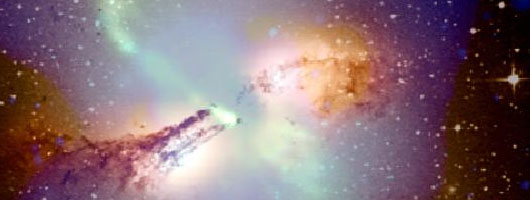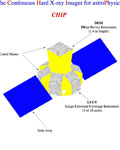CHIP
The Continuous Hard x-ray Imager for astroPhysics

The CHIP proposal was submitted in response to the NASA Announcement of Opportunity for Explorer missions in XXX. It was to be a collaboration between UCSD and Washington University in St. Louis. It was the first UCSD mission proposal utilizing coded mask imaging with CdZnTe detectors. CHIP was not selected for development.
 The Continuous Hard x-ray Imager for astroPhysics, (CHIP) mission concept for 2-100 keV hard X-ray astronomy combines a powerful hard X-ray imaging telescope (10 times more sensitive than HEXTE or OSSE) and a powerful, continuous, hard X-ray all-sky imager (10 times more sensitive than the ASM on XTE and 3 times more sensitive than BATSE). This mission will provide images with 10 arcminute angular resolution of selected portions of the sky 10 times deeper than XTE, will provide high time resolution observations of bright Galactic objects with 10 times better energy resolution at 60 keV than any scintillator mission, and will generate a continuous, hard X-ray, flux-limited all-sky survey a factor of 100 deeper than the HEAO-1 A-4 13-180 keV survey and 10 times deeper than the HEAO-1 A-1 0.25-25 keV survey and HEAO-1 A-2 2-10 keV extragalactic survey. This mission will yield spectra and identifications of several thousand extragalactic objects and about one thousand galactic sources, and will provide greater insights into many classes of astronomical object. In addition, the continuous, all-sky imager will observe several hundred gamma ray bursts per year (twice the BATSE rate) and locate them to <100 square arcminutes (1000 times smaller than the best BATSE derived error boxes). This will undoubtedly advance our knowledge of, if not answer, the question of the origin of gamma ray bursts.
The Continuous Hard x-ray Imager for astroPhysics, (CHIP) mission concept for 2-100 keV hard X-ray astronomy combines a powerful hard X-ray imaging telescope (10 times more sensitive than HEXTE or OSSE) and a powerful, continuous, hard X-ray all-sky imager (10 times more sensitive than the ASM on XTE and 3 times more sensitive than BATSE). This mission will provide images with 10 arcminute angular resolution of selected portions of the sky 10 times deeper than XTE, will provide high time resolution observations of bright Galactic objects with 10 times better energy resolution at 60 keV than any scintillator mission, and will generate a continuous, hard X-ray, flux-limited all-sky survey a factor of 100 deeper than the HEAO-1 A-4 13-180 keV survey and 10 times deeper than the HEAO-1 A-1 0.25-25 keV survey and HEAO-1 A-2 2-10 keV extragalactic survey. This mission will yield spectra and identifications of several thousand extragalactic objects and about one thousand galactic sources, and will provide greater insights into many classes of astronomical object. In addition, the continuous, all-sky imager will observe several hundred gamma ray bursts per year (twice the BATSE rate) and locate them to <100 square arcminutes (1000 times smaller than the best BATSE derived error boxes). This will undoubtedly advance our knowledge of, if not answer, the question of the origin of gamma ray bursts.
Equally important, CHIP will produce 2-100 keV images and catalogs of the entire sky for comparison with observations made at other wavelengths, just as the Palomar Sky Survey, ROSAT Sky Survey, IRAS Sky Survey, the VLA survey, and EUVE Sky Survey are used today. The >10 keV hard X-ray band is of crucial astrophysical importance, since obscuration by intervening Galactic gas and dust does not limit the view of the galaxy or beyond, and because hard X-ray emission frequently originates close to the primary energy release. Extending observations of cosmic X-ray sources from the conventional 2-10 keV range, where techniques using focusing X-ray optics are readily applied, into the higher energy ranges is a central objective of high energy astrophysics. It is in the tens of keV regime where the production by non-thermal processes becomes dominant over thermal emission in many sources, such as binary X-ray sources, supernovae remnants, active galactic nuclei and clusters of galaxies. Indeed, this whole regime has been studied only with limited sensitivity and angular resolution thus far, and many studies for future space missions have indicated the important new knowledge of astrophysical phenomena likely to be obtained with modern instruments operating in this range.
The CHIP hard X-ray imaging mission is comprised of two instruments, which will utilize the room temperature semiconductor CdZnTe in mosaiced arrays of position sensitive devices in conjunction with coded masks. The Large Uniform Coverage Imager (LUCY) contains 18 individual telescopes, each with ~1000 square centimeters of detector area, 1 steradian (60 degrees x 60 degrees) field of view, and 30 arcminute angular resolution. At 20 keV LUCY has a detection sensitivity of 1 mCrab in a day and <0.1 mCrab in a year and continuously views the entire non-occulted sky. The pointed DEep Survey Imager (DESI) will have ~4,000 square centimeters of detector area, 0.01 steradian (5 degreex x 5 degrees) field of view, 10 arcminute angular resolution, and will be optimized for low background and the best sensitivity. It will image selected fields for times up to ~2 weeks at a sensitivity of ~50 microCrab at 20 keV. Each instrument will provide imaging from 2--100 keV with ~1 keV energy resolution throughout the entire energy range. These instruments are made possible by recent advances in relatively large area CdZnTe detectors with fine spatial resolution (100's of microns) and low power, high density read out systems. The instruments' sensitivities over the 2-100 keV energy range guarantee overlap and complementarity at lower energies with ROSAT, ASCA, AXAF, and XMM missions, and at the same time provide links to CGRO and INTEGRAL observations at higher energies.